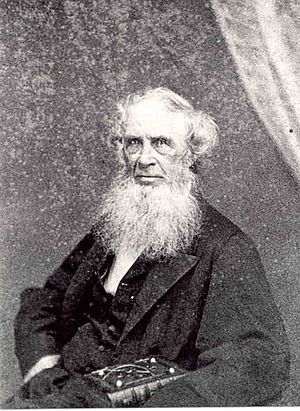Cyrus Pitt Grosvenor facts for kids
Quick facts for kids
Cyrus Pitt Grosvenor
|
|
|---|---|
 |
|
| Born | October 18, 1792 |
| Died | February 11, 1879 (aged 86) |
| Nationality | American |
| Education | Dartmouth College |
| Occupation | Baptist minister |
| Known for | Anti-slavery, education |
| Spouse(s) | Sarah Warner |
| Parent(s) | Rev. Daniel and Deborah Grosvenor |
Cyrus Pitt Grosvenor (born October 18, 1792 – died February 11, 1879) was an important American minister. He was known for his strong beliefs against slavery.
He started a group called the American Baptist Free Mission Society. This group was against slavery. They did not let slave owners become missionaries. They also refused money from anyone who supported slavery. This was a big step before the Baptist Church split into Northern and Southern groups over slavery.
Grosvenor also helped start New York Central College. He was its first president. This college was special because it was the first in the U.S. to welcome both women and Black students equally. It was also the first to hire Black professors. People called him "a reforming steam engine" because he worked so hard for change. Even after retiring, he kept busy. He worked on a famous math problem. He also got a patent for an invention to stop lamps from exploding.
Life Story
Cyrus Pitt Grosvenor was born in Grafton, Massachusetts. His parents were Rev. Daniel and Deborah Grosvenor. He learned about religion from his father. He was once the principal of Haverhill Academy.
Grosvenor graduated from Dartmouth College in 1818. He then studied at Princeton Theological Seminary in 1821–22. From 1825 to 1834, he was a minister in cities like New Haven, Salem, and Boston.
Grosvenor was a leader in the movement to end slavery. He worked in Massachusetts and Connecticut. He was also an agent for the American Anti-Slavery Society. The first meeting of the Essex County Anti-Slavery Society was held at his house.
Cyrus Grosvenor and Elon Galusha were the two main Baptist ministers who spoke out against slavery. Grosvenor supported the Liberty Party. This political party was also against slavery.
In 1840, Grosvenor went to the first World Anti-Slavery Convention in London. He is in a famous painting from that event by Benjamin Haydon. However, his face is partly hidden by other people. A group from Massachusetts also attended. This group included important people like Galusha, George Bradburn, Lydia Maria Child, and William Lloyd Garrison. In the same year, Grosvenor wrote a book. It looked at whether the Bible supported slavery or not.
Grosvenor was the first editor of a newspaper called Baptist Anti-Slavery Correspondent. It was first published in February 1841.
In 1844, Grosvenor helped create a new American missionary society. He was upset that Baptist church leaders were not removing people who owned slaves from the church. He felt a new group was needed to take a stronger stand against slavery. This new group became the American Baptist Free Mission Society.
In 1849, he helped start New York Central College in McGrawville, New York. He was the first president of this college.
Grosvenor married Sarah Warner. They had three children. Their son, Cyrus Pitt Daniel Grosvenor, died young. One daughter, Emma P., also died young. Their other daughter, Sarah Caroline Grosvenor, married Rev. Austin Harman in 1852. They moved to Michigan. Grosvenor and his wife later followed them there. Grosvenor had retired from the college the year after his daughter married. In 1856, Grosvenor’s wife died.
During the American Civil War, Grosvenor went to England. He had to leave the country for his safety due to his strong anti-slavery views.
Science Interests
In 1867, Grosvenor applied for a patent. A patent is a special right given to an inventor. His idea was to prevent lamps from exploding. He wanted to use a gas called nitrogen inside the lamps.
The next year, Grosvenor published a study about a math problem. This problem is called "squaring the circle." It asks if you can draw a square with the exact same area as a given circle. You can only use a compass and a straightedge. Grosvenor wrote a pamphlet called The circle squared. In it, he described a way to find the area of a circle squared. His method gave a value for π (Pi) that was 3.142135… (The actual value of Pi is about 3.14159…).
He described his method like this:
Square the diameter of the circle; multiply the square by 2; extract the square root of the product; from the root subtract the diameter of the circle; square the remainder; multiply this square by four fifths; subtract the square from the diameter of the circle.
His method had a small error. But it was later proven in 1882 that there is no perfect geometric way to "square the circle."
In 1867, Grosvenor received an honorary LLD degree. This is a special Doctor of Laws degree given to honor someone's achievements.
Grosvenor died in Albion, Michigan, in 1879. He was buried at the Riverside Cemetery.


